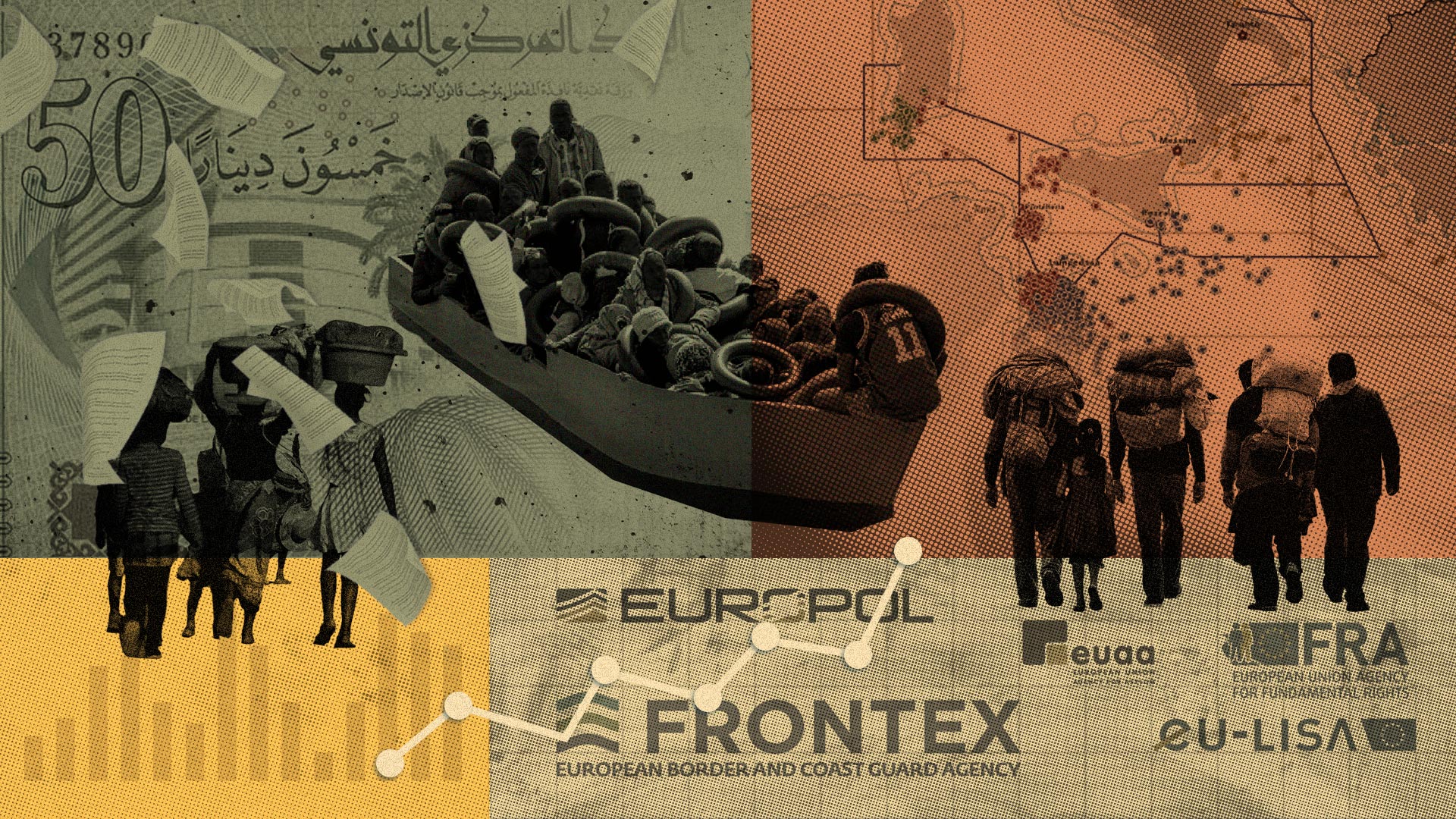Faced with a surge in migrant departures, the Tunisian government, under pressure from its close partnership with the European Union, has ramped up security measures. These include the July 2023 Memorandum of Understanding, backed by substantial financial aid, aimed at tightening border controls and curbing irregular migration.
However, this cooperation has faced sharp criticism. Human rights organizations have condemned practices such as forced expulsions, arbitrary detentions, and widespread violence, raising serious concerns about their compatibility with Tunisia’s international commitments.
At the same time, Tunisia’s rapidly shifting domestic landscape—marked by a deepening economic crisis and an increasingly authoritarian executive branch—has further complicated the situation, fueling diplomatic tensions, particularly with several sub-Saharan African countries.
This investigation, conducted in collaboration with the International Consortium of Investigative Journalists (ICIJ), is based on a leak of nearly 48,000 confidential documents and communications from the European External Action Service (EEAS), the EU’s diplomatic arm.
The documents, sourced from agencies such as the European Border and Coast Guard Agency (Frontex), Europol, and the European Union Asylum Agency (EUAA), unveil the behind-the-scenes security measures and strategies deployed to manage the migration crisis. They provide an unprecedented insight into the security, diplomatic, and humanitarian challenges currently unfolding on Tunisian soil.
Mounting migration pressure
Tunisia has faced unprecedented migratory pressure in recent years, driven by worsening regional crises and growing socio-economic instability. Migration flows have shown significant monthly fluctuations, with some periods marked by alarming spikes and others by temporary lulls—often a direct result of tightened border controls.
Monthly departures from Tunisia compared to other countries (2023-2024)
The Memorandum of Understanding signed on July 16, 2023, aimed at curbing the number of migrants attempting the perilous sea route to Italy, has had a visible impact. Data indicates a reduction in the number of irregular migrants successfully reaching Italian shores.
Cumulative evolution of arrivals in Italy from Tunisia compared to other countries (2023-2024)
This mission aims to monitor the coasts of Algeria, Tunisia, Libya, and Egypt to detect maritime flows that could generate waves of migrants attempting to enter Europe in an irregular way.
A September 2024 report reviewed by inkyfada sheds light on migration trends in the central Mediterranean (Italy and Malta), particularly in the context of Frontex’s joint Themis operation. Despite fluctuating weather conditions, September 2024 saw migration figures consistent with previous months, though a slight decline was noted.
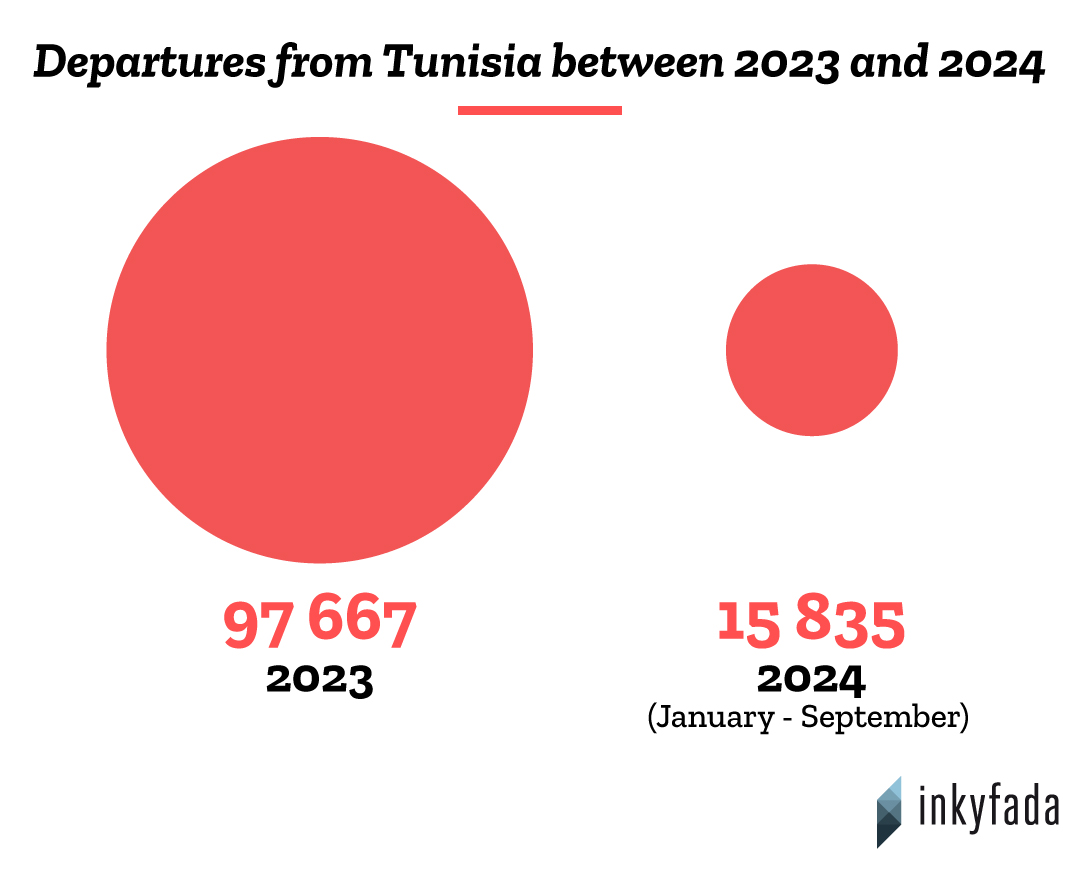
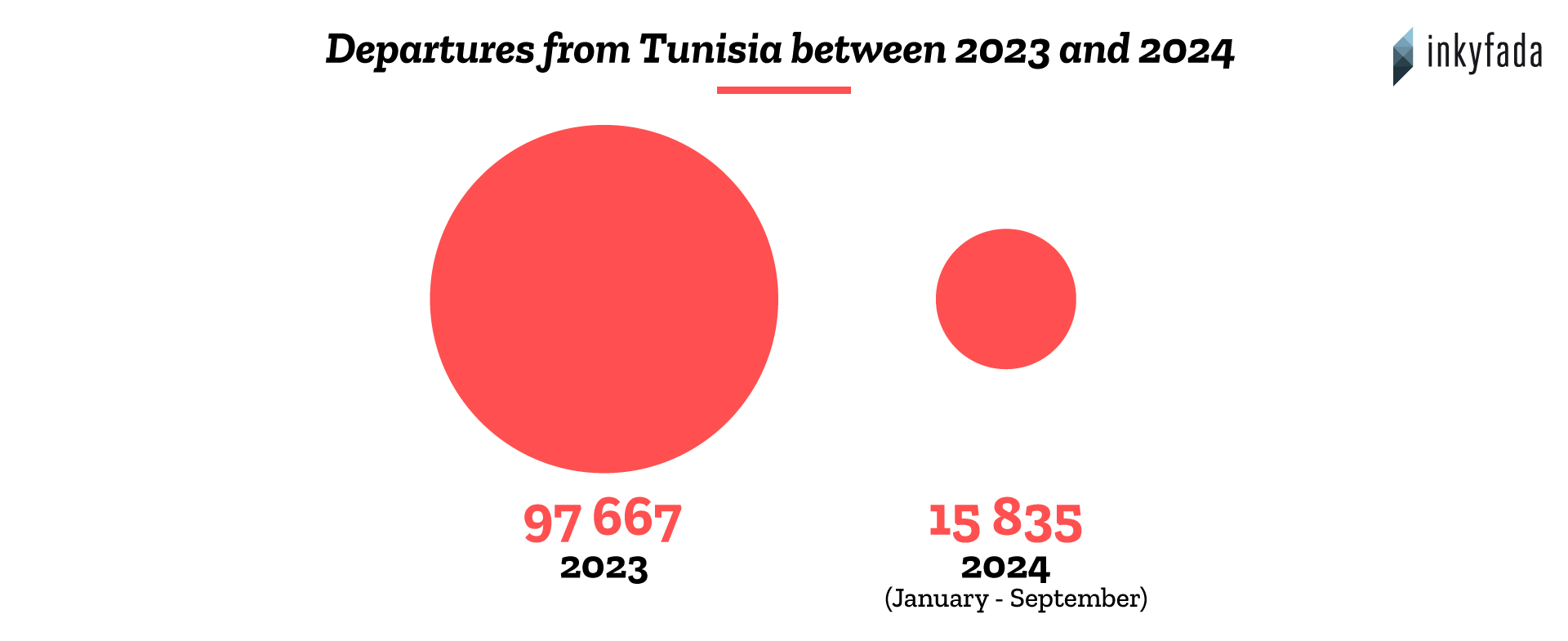
The report also underscores the repercussions of arbitrary measures by Tunisian authorities, including last-minute amendments to the electoral law just days before the October 6, 2024, presidential election, which raised concerns about “the integrity of the ballot.”
Meanwhile, Tunisia’s economy continues to grapple with significant challenges. Unemployment, especially among youth, is steadily rising, fueling migration pressures. The report notes that this economic instability is a
“key driver pushing many Tunisians to seek opportunities in Europe, with little hope for improvement in the near future.”
Cumulative breakdown of migrant nationalities (2017-2024)
Migration flows through Tunisia, however, are not limited to Tunisians. The country remains a key transit hub for sub-Saharan Africans, who accounted for over 55% of departures in 2024, despite a slight decline. Most migrants hail from Guinea, Ivory Coast, Mali, and Sudan—two of which are conflict zones—often after arduous journeys through the Sahel and Libya. For many, Tunisia represents the final stop before Europe: a gateway filled with both hope and fear.
At the same time, migration profiles are also becoming increasingly diverse. Sub-Saharan migrants are now joined by individuals from South Asia and the Middle East. In 2024, Tunisian authorities reported a rise in migrants from Bangladesh, Pakistan, and Iraq.
Iraqi migrants, in particular, have benefited from Tunisia’s new visa policy, which allows them to enter as tourists. A Frontex report from August 2024 highlighted two separate border incidents involving Iraqi migrants attempting to reach Italy via inflatable dinghies and wooden boats. According to the report, these migrants paid smugglers “€10,900 per person, with arrangements often made through social media,” to reach Italy from Tunisia.
Despite these attempts, clandestine crossings remain relatively rare due to harsh conditions and the exorbitant fees charged by smugglers, Frontex notes.
Riskier routes, unequal costs: the shifting dynamics of migration
Over the years, clandestine migration routes in Tunisia have adapted to evolving enforcement strategies and pressure from European partners. While the central Mediterranean remains the primary route for migrants heading to Europe, smuggling networks have grown increasingly sophisticated, devising new methods to bypass controls and meet the rising demand for crossings.
Arrivals in Europe via the Central Mediterranean route compared to other migration routes (2016-2024)
Distribution of crossings to Europe via the central Mediterranean by country of departure (2016-2024)
Sfax, Tunisia’s second-largest city and a major economic hub, has long been the epicenter of illegal departures. Its strategic location and porous border controls have made it a focal point for migrants and smugglers alike. Beaches near the city, particularly in Louata and El-Amra, have become preferred launch points. Migrants often gather in olive groves or abandoned warehouses, waiting for the right moment to set sail.
However, as patrols in the Sfax region intensified and media attention grew, smuggling networks began shifting their operations. The southern coasts, especially near Zarzis and the island of Djerba, have emerged as alternative departure points. These less-monitored areas, coupled with their proximity to Italian islands, offer strategic advantages for smugglers.
More recently, departures have even been reported from Tunisia’s northern coasts, a move described by Frontex in a September 2024 report as an attempt to “diversify routes and outmaneuver authorities.”
The type of vessels used by smugglers has also evolved in response to security pressures. Traditionally, migrants took to the sea in small wooden boats or inflatable zodiacs.

Images: Frontex, Ansa.it
The types of vessels used have also evolved in response to heightened security measures. While small wooden boats and inflatable zodiacs were once the norm, makeshift metal boats have dominated since 2022. Built in clandestine workshops around Sfax, these boats are crafted from recycled sheet metal and can carry up to 100 passengers per crossing, offering a low-cost, high-capacity solution for smugglers.
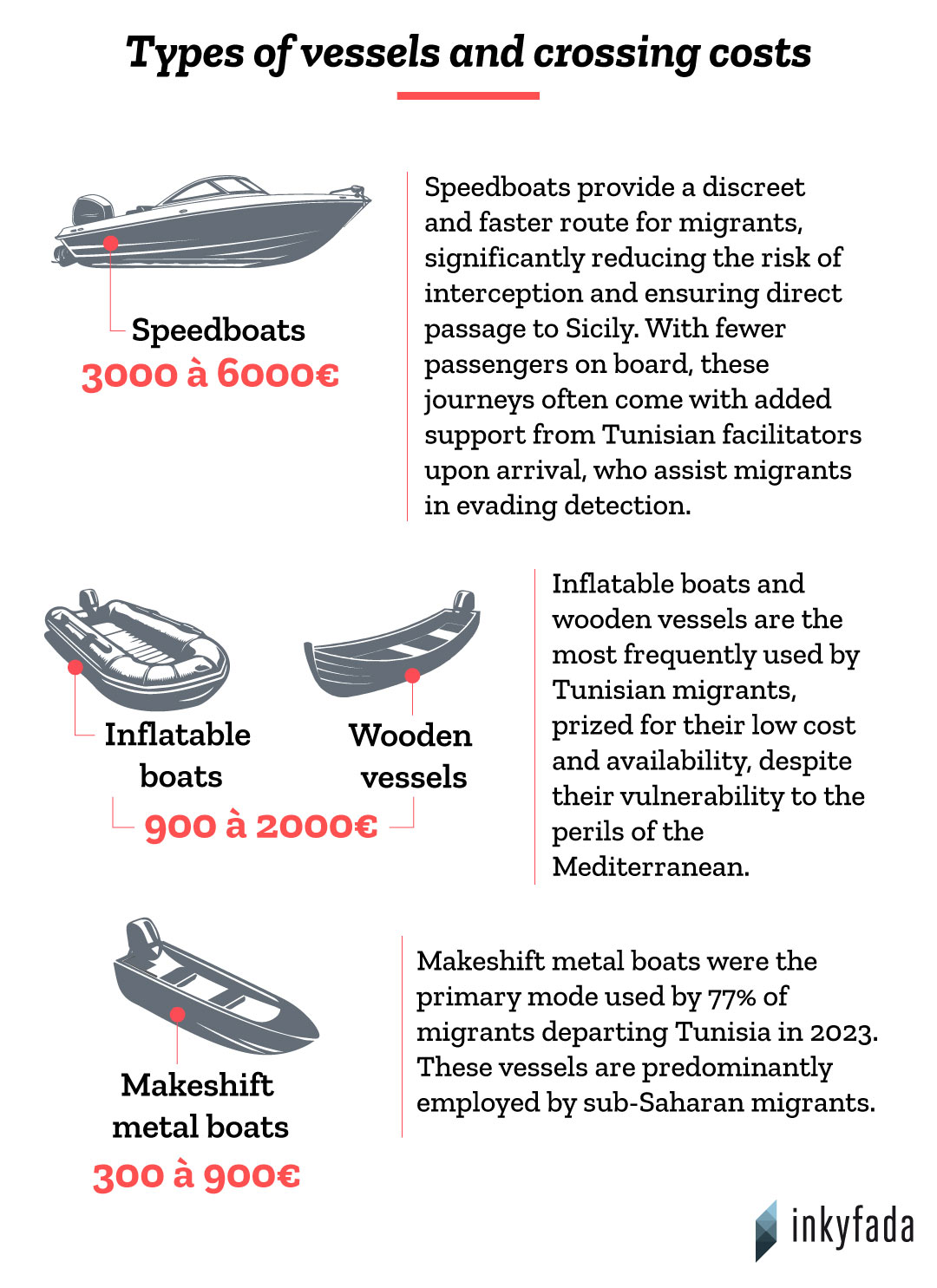
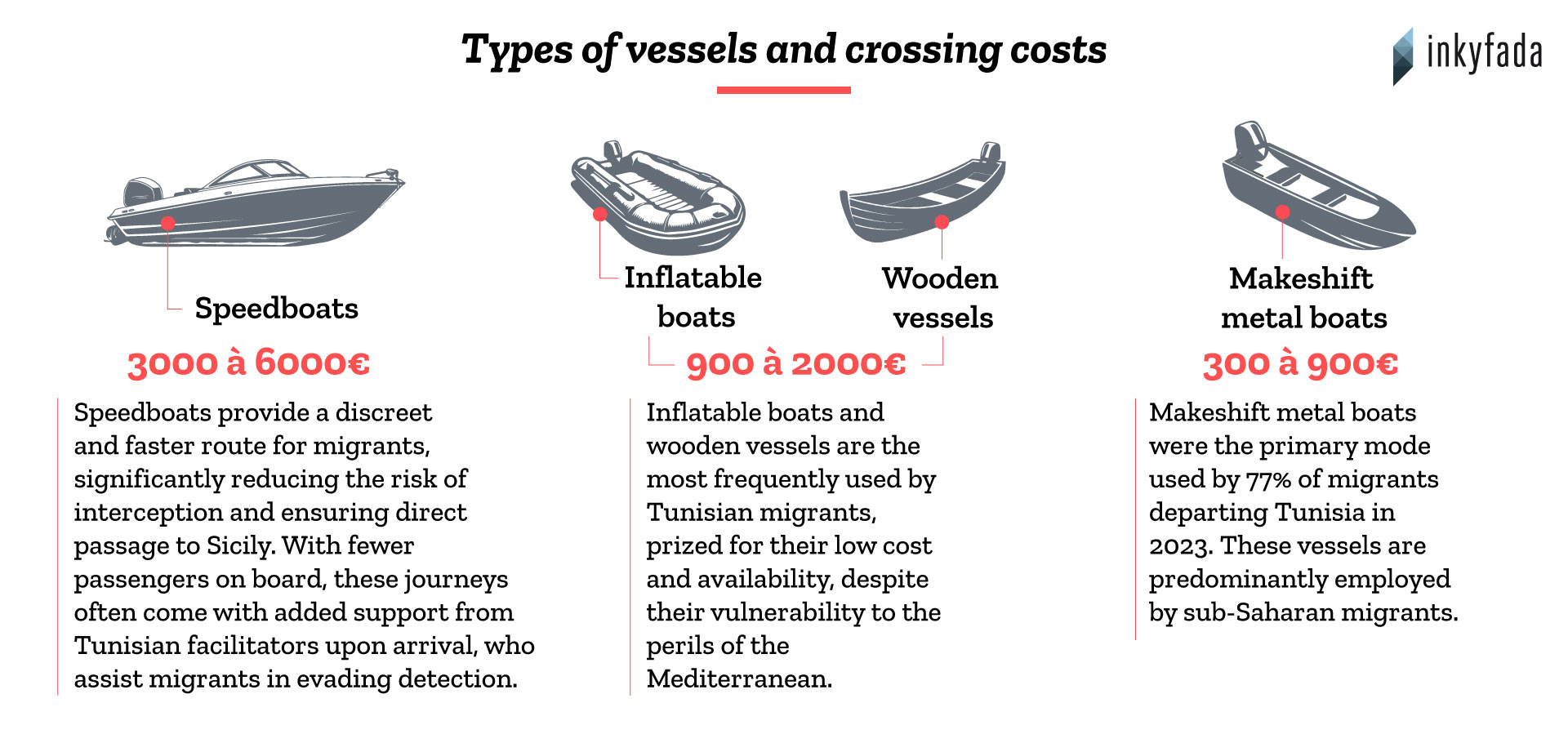
The economics of Mediterranean crossings reveal stark inequalities. Fares vary significantly depending on migrants’ nationalities and the services provided. For sub-Saharan Africans, the cost of crossing from Tunisia ranges from €300 to €800. In contrast, Asian migrants often face much higher prices, as smugglers perceive them as more financially capable “clients”.
For migrants from Bangladesh or Pakistan, fees can reach up to €4,000, reflecting the comprehensive “packages” offered by smugglers. These packages sometimes include forged documents, Tunisian tourist visas, and temporary accommodation before departure.
However, the most affordable option—makeshift metal boats—comes at a deadly cost. Despite their seemingly sturdy appearance, these vessels are often overloaded and lack basic safety equipment, making crossings extremely hazardous. Many of the shipwrecks recorded in 2023 and 2024 involved metal boats, which frequently proved unable to withstand the Mediterranean’s unpredictable weather.
Number of deaths recorded in the Central Mediterranean compared to total deaths recorded in the Mediterranean (2016-2024)
Smuggling networks have demonstrated remarkable adaptability in evading law enforcement. One common tactic is organizing mass departures, where dozens of boats set sail simultaneously from a single location, overwhelming the capacity of coastguards. This “saturation strategy” ensures that even if some boats are intercepted, others will slip through. In September 2024, Frontex reported that smugglers used this method in Annaba and El Kala, Algeria, to avoid detection by the Algerian coastguard.
Corruption within law enforcement has also facilitated these operations. Reports reviewed by inkyfada reveal instances of complicity involving Tunisian authorities. For example, on February 21, 2024, Italian authorities dismantled a human trafficking ring, arresting 12 individuals—including six Italians and six Tunisians, among them a corrupt former Tunisian police officer. The group allegedly operated cells in both Tunisia and Italy, organizing small-scale crossings (up to 20 people) at premium prices of €3,000 to €6,000 per person, far exceeding the costs of overcrowded boats.
Operational intelligence obtained by inkyfada suggests deeper collusion. Documents indicate that “criminal groups specializing in trafficking Tunisian nationals have struck deals with local authorities on Tunisia’s northeast coast to allow migrant departures.” Frontex notes that these networks appear to be “acting in collusion with a high-ranking Tunisian officer.”
Similar to tactics used by particular criminal groups in Libya, smugglers employ specific markings—painted on boats or inscribed on life jackets—to help corrupt coastguards identify and allow “protected” vessels to pass unchecked.
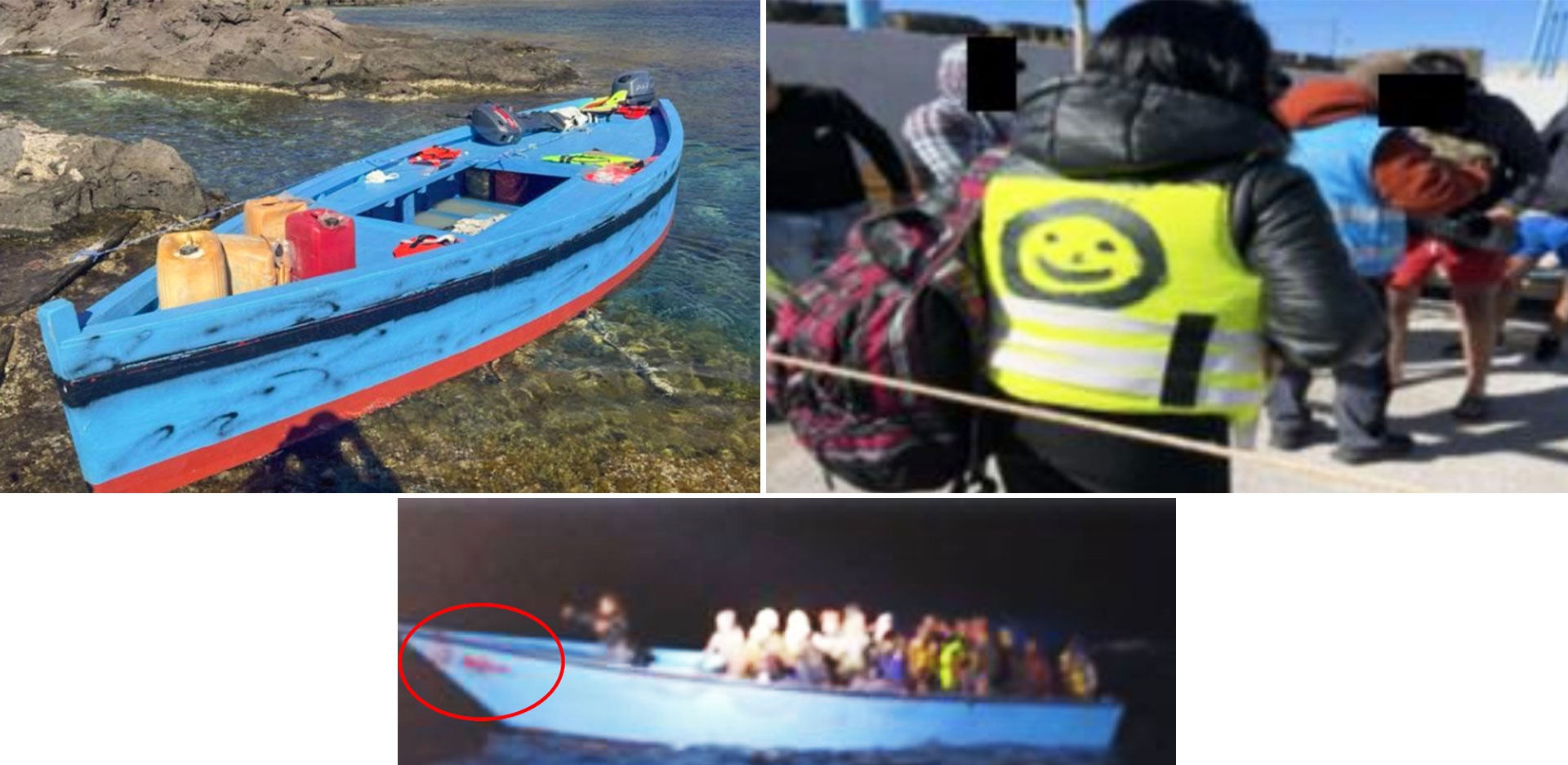
Images: Frontex
European migration policies, including bilateral agreements between the EU and Tunisia, have directly influenced the evolution of these routes. Interception strategies like the EUNAVFOR MED IRINI operation have also forced smugglers to adapt, shifting their migration routes.
A security-driven response shaped by European influence
For years, Tunisia has tackled the migration crisis by ramping up security measures, largely under European pressure. Increased patrols, camp dismantling, mass arrests, and expulsions have become the primary tools to curb migration flows.
While these measures have occasionally led to temporary declines in departures, they have also worsened living conditions for migrants and sparked concerns over human rights violations.
Persistent delays in validating incidents and the absence of precise data on migrant departures highlight the shortcomings of the EU’s security-driven approach to managing migration in Tunisia. "In August alone, approximately 800 migrants had an unknown last country of departure," Frontex noted in an August 2024 report.
The agency also pointed to "local corruption in Tunisia and Libya as a major obstacle to implementing effective preventive measures.” Meanwhile, thousands of migrants remain stranded along the coasts, poised to risk their lives attempting the perilous Mediterranean crossing.
Reports from NGOs and international organizations consistently underscore that these measures fail to address the root causes of migration and instead worsen the plight of irregular migrants. The absence of adequate protection mechanisms and genuinely viable voluntary return options has created a vicious cycle: repeated expulsions often lead to renewed attempts to migrate.
This approach has also sparked significant diplomatic tensions. Incidents with countries such as Côte d'Ivoire and the African Union have revealed widespread dissatisfaction, with many viewing Tunisia’s migration policy as discriminatory and overly aggressive toward their nationals.
Burkina Faso and Côte d'Ivoire temporarily recalled their ambassadors in protest, accusing Tunis of systemic racism against their citizens. The diplomatic rift deepened during a tripartite meeting involving the African Union, the European Union, and the United Nations, where a Burkinabe diplomat publicly condemned Tunisian authorities for conducting "illegal deportations" and "endangering the lives of thousands of migrants."
"Around the table, diplomats from key migrant-origin countries [...] debate migration management strategies. Tensions flare between Burkinabe and Tunisian representatives as the former voice concerns over alleged mistreatment of sub-Saharan migrants in Tunisia," reads an excerpt from an internal note dated March 2, 2024, reportedly authored by Nicola Orlando, the EU ambassador to Libya.
The hardline approach has also drawn criticism for its lack of humanitarian solutions. A lack of alternatives to detention, overcrowded reception centers, and controversial expulsion practices have raised serious questions about the long-term effectiveness and sustainability of Tunisia’s migration policies.
